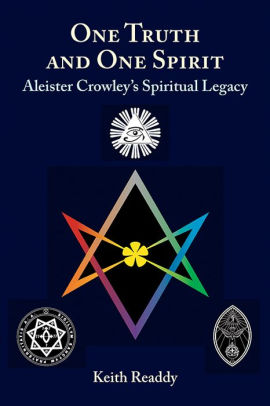This scholarly, heavily researched book is devoted to tracing Crowley's development of Thelema through his lifetime, and the winding path of Thelema after his death in 1947. Readdy is an able writer who has treated the masses of references in an orderly and sensitive manner, with the added benefit of footnotes instead of endnotes. This makes all the difference in the world for the reader's clarity, as the footnotes offer explications, additional references, and citations to private papers and books mentioned in the text.
The text is divided into three parts. Part I – “Thelema: The Law of a New Aeon” begins with Crowley's meteoric rise through the Hermetic Order of the Golden Dawn and the channeled messages he received through his wife Rose during their honeymoon in Egypt. These messages were the seed of Thelema. More messages were received through workings with various magical partners between that time and the late 1910s. The personal history covers details of how Crowley became involved with and eventually became the leader of the O.T.O. around 1925. After taking leadership, Crowley refashioned the O.T.O. into an external Thelemic organization that provides members with rituals and fellowship. The A:A: was developed alongside as the internal order of Thelema, which is devoted to solitary individual study and personal development through the various levels of initiation mirroring similar initiation levels in the O.T.O.. The chain of events is supplemented with quotes from the numerous publications Crowley wrote through this period, and emphasizes the role of publications in making Thelema accessible to others.
Part II – “The Thelemic Movement: History and Publication (1962-1998)” covers the low point after Crowley's death, and how the Agape Lodge in Los Angeles kept the tradition alive. The individuals dedicated to sustaining Thelema and their activities are explained through a detailed chronology of events. Chapter 9 describes the critical turning point from 1969 – 1975, when the organization's leaders pushed to get the core documents republished and distributed to the public. It summarizes various battles for leadership positions during this revitalization period. Chapter 12 – "The Digital Magus" describes the progress of Thelema since the advent of the Internet, which offers greater accessibility and connections between members in diverse locations. It also treats the side effect of arguments and falsified information that is spread through the internet as well. Several pages of photographs depicting individuals important to the movement are appended at the end of this section.
Part III – “One Truth and One Spirit: Aleister Crowley's Spiritual Legacy” completes the text with details about the current relationship between the O.T.O. and the A:A:. At this point, people aren't generally members in both organizations, or even official members of either group since self-study materials are readily accessible. The O.T.O lacks “a definite curricula or set examinations in most degrees.” (p. 191) The author discusses the risks of the order becoming dogmatic and dictatorial. There are ongoing efforts to bring the O.T.O. and the A:A: back in harness. A potential unifying link is discussed in Chapter 14 – "The Ecclesia Gnostica Catholica and the Gnostic Mass." The Gnostic Catholic Church (EGC) was established in the late 19th century in France. It was transformed into a “Church of Thelema” by the Agape Lodge in the 1930s. It has expanded since the 1990s by performing rites of passage like marriages, baptisms and other sacraments. The Church's ordination policy is one of the most progressive in existence. The final chapter discusses Thelema and its various arms from the standpoint of inclusion in Western esotericism, and the as-yet limited academic studies in this field. Thelema is both occult and religious, and doesn't fit easily into definitions or sociological models for either. The occult is often pegged as being “deviant” or “fringe,” yet these descriptors are insufficient and incorrect as alternative spiritual paths are expanding at a furious rate in the early 21st century. Thelema's various branches are becoming more coherent and unified, but the organization still struggles with negative press, and “schism, sectarianism, and factionalism” (p. 350).
End matter includes a detailed bibliography with a comprehensive listing of works by Crowley, followed by an extensive list of works by other authors, and an index.
Readdy is an independent scholar of religion and philosophy and a member of the O.T.O and the A:A:. He has professional and personal reasons for producing this text. Some readers may find that some of Uncle Al's shenanigans are shamelessly whitewashed; but this is not a biography of Crowley and discussions on those topics are treated in other books.
This text is critically important as it provides a context for the past, present and future of Thelema and its organizations. The early 21st century has become a watershed period for syncretic religion/spiritual movements. Thelema offers a uniquely modern spiritual and philosophical platform for personal development created by the 20th century occult's most rigorously intellectual scholar. One of the earliest channeled messages was that this spiritual discipline is part of a new Aeon. One of the main historic identifiers of the change from one Aeon to the next is that old religions lose coherence and new religions take their place. This text is a singular contribution to Crowleyana, the development of a modern religion, its continuing existence and place in the social-cultural milieu of the 21st century. The author is to be commended for producing a beautifully researched text that makes this complicated subject coherent and accessible.
~Review by Elizabeth Hazel
Author: Keith Readdy with a foreword by Vere Chappell
2018, Ibis Press/Nicolas-Hays, Inc.
392 pages, $35.00 HB
One Truth and One Spirit: Aleister Crowley's Spiritual Legacy

©
2010 - 2025
Facing North
